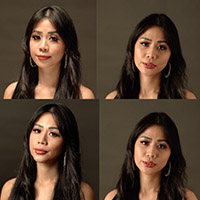Video: 3 ways to bounce a single light to improve your portrait photography
posted Wednesday, May 25, 2022 at 12:00 PM EDT

In his latest "Laws of Light" photography tutorial, Jay P. Morgan of The Slanted Lens shows how you can capture nice portraits with a diverse range of looks using only a single light and utilizing a bounce light technique.
Bounce light is when you have a single light, and rather than pointing it directly at your subject, you bounce it off a reflective surface. It could be a ceiling, wall, or even a specialized tool like a reflector. You can even use a bounce light without any artificial lights. If you're outside, you can use a reflector to bounce light toward your subject or bounce light coming in through a window to light a portrait.
The primary reason you'd use bounce light instead of pointing a light source at a subject is that you create a larger, softer light by bouncing your light off a bounce surface. If you point a light at the wall or ceiling, it's almost like you're shooting with a large softbox. "It just gives you a beautiful, beautiful look," says Morgan. He also uses the technique for video when shooting in a small room because he doesn't have the space to use multiple lights and large modifiers.
In the video above, Morgan shows off three different ways to utilize bounce light and a single light. The most common approach he uses is to bounce the light off the ceiling. Many rooms have eight to ten-foot ceilings, so this approach works well. If you're in a room with very tall ceilings, you'll want to try the second technique, bouncing your light off a reflector. With this bounce method, you've got a bit more control and can easily make light softer or harder by changing the distance between the light and reflector and the reflector and your subject. If you want even more control, the third technique, bouncing light off a v-flat, offers the most flexibility.
Watch the full video above to see a bonus section about how adding a second light can transform your bounce light setup. For more videos like this, head over to The Slanted Lens on YouTube or visit their website.
(Via The Slanted Lens)